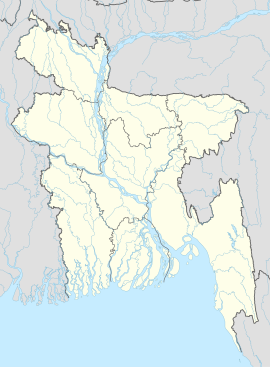Sonargaon
| সোনারগাঁও | |

Shown within Bangladesh
|
|
| Location | Near Narayanganj |
|---|---|
| Coordinates | 23°38′51″N 90°35′52″ECoordinates: 23°38′51″N 90°35′52″E |
It was an administrative centre of Fakhruddin Mubarak Shah's sultanate, the Bengal Sultanate and the Kingdom of Bhati.
The area is located near the modern industrial river port of Narayanganj in Bangladesh. Today, the name Sonargaon survives as the Sonargaon Upazila (Sonargaon Subregion) in the region.
Contents
- 1 History
- 1.1 Pre-Muslim period
- 1.2 Muslim period
- 1.2.1 Isa Khan's rule
- 1.3 British period
- 1.4 Bangladesh period
- 2 Trade
- 3 See also
- 4 References
- 5 Further reading
- 6 External links
History
Part of a series on the
|
|---|
| History of Bangladesh |
 |
|
Pre-Muslim period

Bara Sardar Bari called Isa Khan's bari in Sonargaon.
Muslim period

The 7th voyage of Zheng He's fleet map based on analysis by Edward L. Dreyer shows that Hong Bao and Ma Huan visited Sonargaon in 1432.
Firoz Shah built a mint in Sonargaon from where a large number of coins were issued. When he died in 1322, his son, Ghiyasuddin Bahadur Shah, replaced him as the ruler. In 1324 Delhi Sultan, Ghiyasuddin Tughlaq, declared war against him and after the battle, Bahadur Shah was captured and Bengal, including Sonargaon, became a province of Delhi Sultanate. The same year, Sultan Muhammad bin Tughlaq, son and successor of Ghiyasuddin Tughlaq, released him and appointed him as the governor of Sonargaon province.
After 4 years of governorship, in 1328, Bahadur Shah declared independence of Bengal. Delhi Sultan Muhammad bin Tughlaq sent his general, Bahram Khan, to depose him. In the battle, Bahadur Shah was defeated and killed. Bahram Khan recaptured Sonargaon for the Delhi Sultanate and he was also appointed the governor of Sonargaon.
When Bahram Khan died in 1338, his armour-bearer, Fakhruddin Mubarak Shah, declared himself the independent Sultan of Sonargaon. Fakhruddin sponsored several construction projects, including a trunk road and raised embankments, along with mosques and tombs.14th century Moroccan traveller, Ibn Batuta, after visiting the capital in 1346, described Fakhruddin as "a distinguished sovereign who loved strangers, particularly the fakirs and sufis".After the death of Fakhruddin in 1349, Ikhtiyaruddin Ghazi Shah became the next independent ruler of Sonargaon.
Ilyas Shah, the independent ruler of Lakhnauti, attacked Sonargaon in 1352. After defeating Ikhtiyaruddin Ghazi Shah, he became the sole ruler of whole Bengal for the first time in history and thus he became the founder of a sultanate of the unified Bengal.
A squadron of the Chinese fleet of Zheng He, commanded by the eunuch visited Sonargaon in 1432. The information about that expedition comes from the book of one of its participants, the Muslim translator Ma Huan. In 1451 Huan wrote his experience in details in his book Yingyai Shenglan (The Overall Survey of the Ocean's Shores).
Sonargaon is the eastern terminus of the Grand Trunk Road, which was built by the Pashtun emperor Sher Shah Suri and extended approximately 2500 kilometres from Bangladesh across northern India and Pakistan to Kabul in Afghanistan.
Isa Khan's rule
When Taj Khan Karrani was the independent Afghan ruler of Bengal, Isa Khan obtained an estate in Sonargaon and Maheswardi Pargana in 1564 as a vassal of the Karrani rulers. Isa Khan gradually increased his strength and in 1571 he was designated as the ruler of the whole Bhati region. In 1575 he helped Daud Khan Karrani fight the Mughal flotilla in the vicinity of Sonargaon.Daud Khan Karrani died in the Battle of Raj Mahal against Mughals in 1576. Akbar then made Isa Khan the zamindar of Sonargaon, making him one of the Baro-Bhuiyans. However, he continued resisting Mughal rule. With the help of his allies, he stood defiant against Mughals in battle against Subahdar Khan Jahan in 1578, Subahdar Shahbaz Khan in 1584 and Durjan Singh in 1597. Isa Khan died in September 1599. His son, Musa Khan, then took control of the Bhati region. But after the defeat of Musa Khan on 10 July 1610 by Islam Khan, the army general of Mughals, Sonargaon became one of the sarkars of Bengal subah. The capital of Bengal was then shifted to Jahangirnagar (later named Dhaka).
British period

Old Panam City

Panam City
(Panam Nagor) after renovation
Sonakanda Fort is a Mughal river-fort located on the bank of the Shitalakshya River at Bandar.
Bangladesh period
Lok Shilpa Jadughar (Folk Art and Craft Museum) of Sonargaon was established by Bangladeshi painter Joynul Abedin on 12 March 1975.The house, originally called Bara Sardar Bari, was built in 1901.On 15 February 1984, Narayanganj subdivision was upgraded to a district by the Government of Bangladesh.Hence Sonargaon became a subdistrict of Narayanganj District of Dhaka division.
Due to the many threats to preservation (including flooding and vandalism), Sonargaon was placed in 2008 Watch List of the 100 Most Endangered Sites by the World Monuments Fund.
Trade
By the 14th century Sonargaon became a commercial port. Trade activities were mentioned by travellers like Ibn Batuta, Ma Huan and Ralph Fitch. Maritime ships travelled between Sonargaon and southeast/west Asian countries.Muslin was produced in this region.See also
- Isa Khan
- Fakhruddin Mubarak Shah
- Sonargaon Upazila
- Panam City (Panam Nagor)
No comments:
Post a Comment